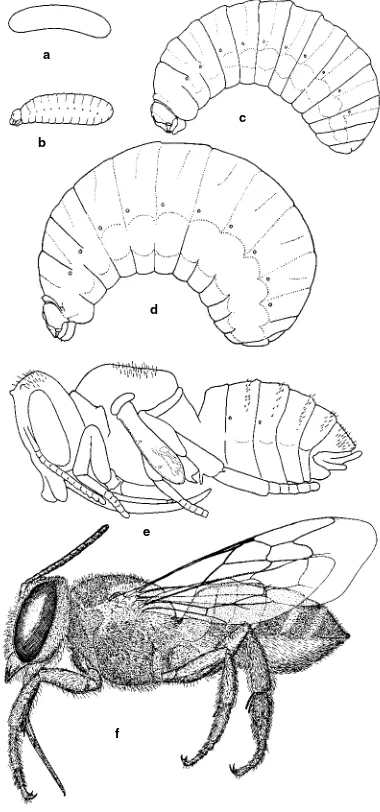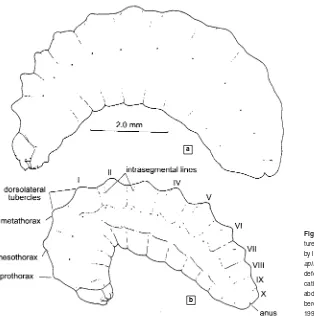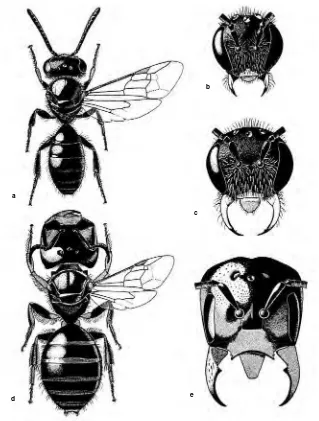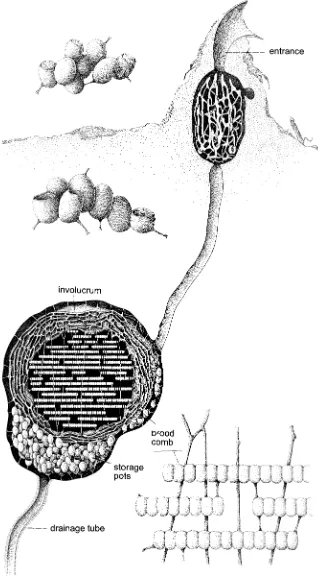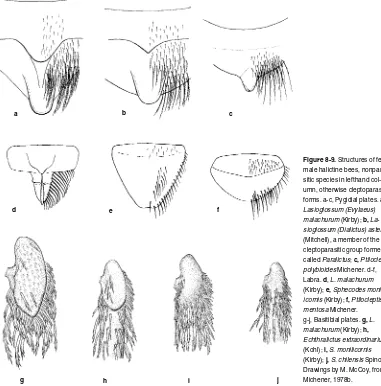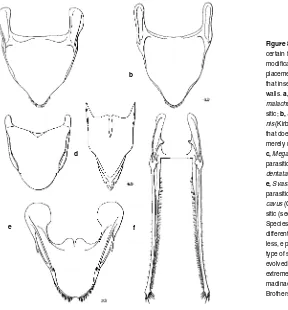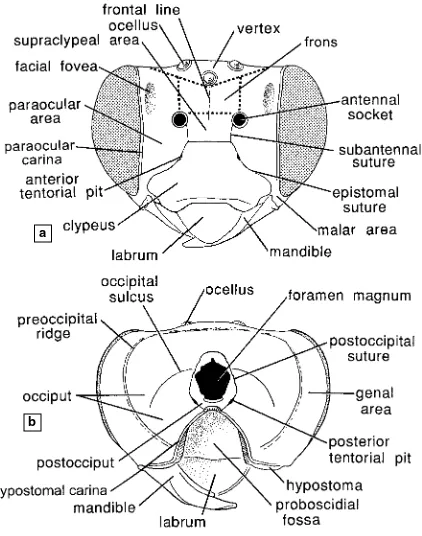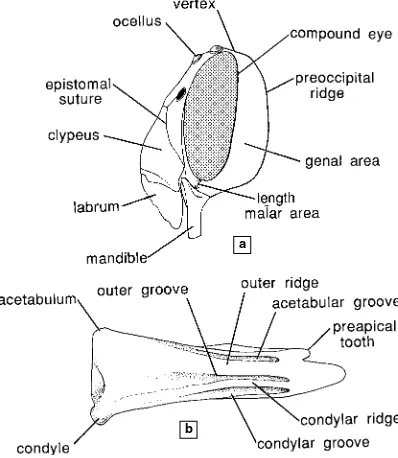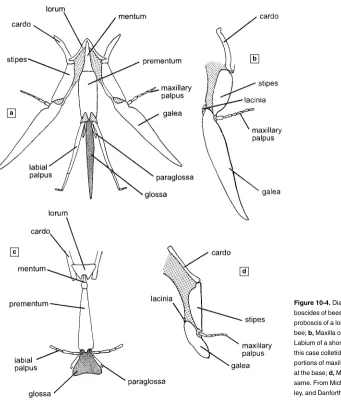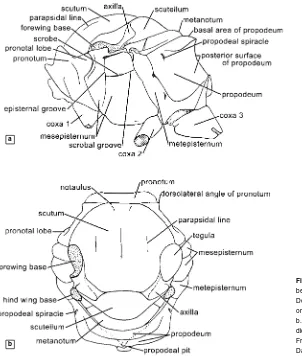of theWorld
SECOND EDITION
Charles D. Michener
Entomology Division
University of Kansas Natural History Museum
and Biodiversity Research Center
and
Entomology Program, Department of Ecology
and Evolutionary Biology
University of Kansas
© 2000, 2007 The Johns Hopkins University Press All rights reserved. Published 2007
Printed in the United States of America on acid-free paper 9 8 7 6 5 4 3 2 1
The Johns Hopkins University Press 2715 North Charles Street Baltimore, Maryland 21218-4363 www.press.jhu.edu
Library of Congress Cataloging-in Publication Data Michener, Charles Duncan, 1918–
The bees of the world / Charles D. Michener.—2nd ed. p. cm.
Includes bibliographical references.
ISBN-13: 978-0-8018-8573-0 (hardcover : alk. paper) ISBN-10: 0-8018-8573-6 (hardcover : alk. paper) 1. Bees—Classification. I. Title.
QL566.M53 2007
595.79⬘9—dc22 2006023201
A catalog record for this book is available from the British Library.
To my many students, now scattered over the world,
from whom I have learned much
Preface to the Second Edition
ixPreface to the First Edition
xiAbbreviations
xvi1. About Bees and This Book
12. What Are Bees?
33. The Importance of Bees
44. Development and Reproduction
65. Solitary versus Social Life
126. Floral Relationships of Bees
167. Nests and Food Storage
238. Parasitic and Robber Bees
309. Body Form, Tagmata, and Sex
Differences
4210. Structures and Anatomical Terminology
of Adults
4411. Structures and Terminology
of Immature Stages
5712. Bees and Sphecoid Wasps as a Clade
5913. Bees as a Monophyletic Group
6014. The Origin of Bees from Wasps
6315. Classification of the Bee-Sphecoid
Clade
6516. Bee Taxa and Categories
6617. Methods of Classification
7618. The History of Bee Classifications
7719. Short-Tongued versus Long-Tongued
Bees
8320. Family-Level Phylogeny and the
Proto-Bee
8821. The Higher Classification of Bees
9322. Fossil Bees
9823. The Geological History of Bees
10024. Diversity and Abundance
10225. Dispersal
10526. Biogeography
10627. Reduction or Loss of Structures
11028. New and Modified Structures
11229. Family-Group Names
11730. Explanation of Taxonomic Accounts
in Sections 36 to 121
11831. Some Problematic Taxa
12032. The Identification of Bees
12133. Key to the Families, Based on Adults
12234. Notes on Certain Couplets in the Key
to Families (Section 33)
12635. Practical Key to Family-Group Taxa,
Based on Females
12736. Family Stenotritidae
12937. Family Colletidae
13238. Subfamily Colletinae
13639. Tribe Paracolletini
13840. Tribe Colletini
16741. Tribe Scraptrini
17142. Subfamily Diphaglossinae
17343. Tribe Caupolicanini
17444. Tribe Diphaglossini
17745. Tribe Dissoglottini
17946. Subfamily Xeromelissinae
18047. Subfamily Hylaeinae
18748. Subfamily Euryglossinae
22049. Family Andrenidae
23550. Subfamily Alocandreninae
23851. Subfamily Andreninae
239Contents
viii
52. Subfamily Panurginae
27053. Tribe Protandrenini
27354. Tribe Panurgini
28555. Tribe Nolanomelissini
29056. Tribe Melitturgini
29157. Tribe Protomeliturgini
29558. Tribe Perditini
29659. Tribe Calliopsini
30660. Subfamily Oxaeinae
31661. Family Halictidae
31962. Subfamily Rophitinae
32263. Subfamily Nomiinae
33264. Subfamily Nomioidinae
34565. Subfamily Halictinae
34866. Tribe Halictini
35467. Tribe Augochlorini
39368. Family Melittidae
41369. Subfamily Dasypodainae
41670. Tribe Dasypodaini
41771. Tribe Promelittini
42272. Tribe Sambini
42373. Subfamily Meganomiinae
42674. Subfamily Melittinae
42975. Family Megachilidae
43476. Subfamily Fideliinae
43677. Tribe Pararhophitini
43778. Tribe Fideliini
43879. Subfamily Megachilinae
44180. Tribe Lithurgini
44481. Tribe Osmiini
44882. Tribe Anthidiini
49183. Tribe Dioxyini
53884. Tribe Megachilini
54385. Family Apidae
58786. Subfamily Xylocopinae
59287. Tribe Manueliini
59588. Tribe Xylocopini
59689. Tribe Ceratinini
61190. Tribe Allodapini
61991. Subfamily Nomadinae
63392. Tribe Hexepeolini
63793. Tribe Brachynomadini
63994. Tribe Nomadini
64395. Tribe Epeolini
64696. Tribe Ammobatoidini
65397. Tribe Biastini
65698. Tribe Townsendiellini
65999. Tribe Neolarrini
660100. Tribe Ammobatini
661101. Tribe Caenoprosopidini
666102. Subfamily Apinae
667103. Tribe Isepeolini
672104. Tribe Osirini
674105. Tribe Protepeolini
678106. Tribe Exomalopsini
680107. Tribe Ancylini
685108. Tribe Tapinotaspidini
687109. Tribe Tetrapediini
694110. Tribe Ctenoplectrini
697111. Tribe Emphorini
700112. Tribe Eucerini
707113. Tribe Anthophorini
742114. Tribe Centridini
753115. Tribe Rhathymini
762116. Tribe Ericrocidini
763117. Tribe Melectini
770118. Tribe Euglossini
778119. Tribe Bombini
785120. Tribe Meliponini
803121. Tribe Apini
830Literature Cited
833Addenda
905Index of Terms
907Index of Taxa
913Of course I was pleased when Johns Hopkins University Press indicated
an interest in a revised edition of
The Bees of the World.
A large review or revisional work like the original
The Bees of the World
inevitably goes out of date as new findings or interpretations are made,
and also as errors or omissions in the original book are discovered.
For the original edition (usually referred to below as Michener, 2000)
relevant publications were surveyed through 1997, with some additional
material being included as addenda or otherwise as it came to my notice
into 1999. Some publications that appeared in 1998 and 1999 were not
cited or were inadequately utilized and are now properly incorporated, as
are the items in the Addenda of the original edition. For the second
edi-tion, I have tried to cover literature through 2005, with additional
mate-rial for 2006.
As in the original edition, arbitrary decisions about rank or recognition
of taxa were often needed. Some recently proposed genera and subgenera
are synonymized below, even though they constitute recognizable and
even useful groups, because I am following so far as possible the practices
involved in writing the first edition. The main point is that the
classifica-tion should represent relaclassifica-tionships, or similarities when phylogenetic
re-lationships are in doubt. A classification that emphasizes differences can
result in an unnecessary multiplication of taxa that (1) often can be
dis-tinguished only with difficulty or (2) represent odd derivatives whose
re-lationships are better represented by inclusion within the recognized
groups. There is no doubt, however, that some of the taxa here
syn-onymized will be resurrected when new classifications are proposed,
based on phylogenetic hypotheses that are yet to be developed.
Noteworthy developments in recent years are the number of
phylo-genetic analyses based on molecular characters, morphological characters,
or both, prepared for groups of bees, and the classificatory changes based
on these analyses. When the hypotheses are robust, I have modified the
text in response. When it seems that changes in taxa studied or in the
characters included in the analyses would change the outcome
consider-ably, I usually report the study but, for the sake of stability, I do not
change the classification. Changes in classifications as a result of
clado-grams subject to major change are not justified, because stability is an
important feature for classifications. We should change a classification
when we know that the change is justified, but otherwise we should not.
Preface to the Second Edition
x
The acknowledgments for the first addition still stand, of course. Some
of those listed have generously provided additional help. Other persons
who have helped for this edition, as follows:
John S. Ascher, New York City, New York, USA;
Michael S. Engel, Lawrence, Kansas, USA (the color photos and plates
of fossil bees, etc.);
Molly G. Rightmyer, Lawrence, Kansas, USA (Epeolini);
Allan H. Smith-Pardo, Lawrence, Kansas, USA (Augochlorini);
Michael Terzo, Mons, Belgium (Ceratina).
I especially appreciate the contribution of “Key to the Subgenera of
Cen-tris” by Ricardo Ayala, Estacion Chamela, Instituto de Biologia,
Univer-sidad Nacional Autonama de México, Ciudad de México.
I also appreciate the careful typing and editing by Anna J. Michener.
xi
Preface to the First Edition
In some ways this may seem the wrong time to write on the systematics
of the bees of the world, the core topic of this book. Morphological
in-formation on adults and larvae of various groups has not been fully
de-veloped or exploited, and molecular data have been sought for only a few
groups. The future will therefore see new phylogenetic hypotheses and
improvement of old ones; work in these areas continues, and it has been
tempting to defer completion of the book, in order that some of the new
information might be included. But no time is optimal for a systematic
treatment of a group as large as the bees; there is always significant
re-search under way. Some genera or tribes will be well studied, while others
lag behind, but when fresh results are in hand, the latter may well
over-take the former. I conclude, then, that in spite of dynamic current
activ-ity in the field, now is as good a time as any to go to press.
This book constitutes a summary of what I have been able to learn
about bee systematics, from the bees themselves and from the vast body
of literature, over the many years since I started to study bees, publishing
my first paper in 1935. Bee ecology and behavior, which I find fully as
fascinating as systematics, are touched upon in this book, but have been
treated in greater depth and detail in other works cited herein.
After periods when at least half of my research time was devoted to
other matters (the systematics of Lepidoptera, especially saturniid moths;
the biology of chigger mites; the nesting and especially social behavior of
bees), I have returned, for this book, to my old preoccupation with bee
systematics. There are those who say I am finally finishing my Ph.D.
thesis!
xii
became more proficient in running small Hymenoptera, including bees,
through the keys in Comstock’s
Introduction to Entomology
.
Southern California has a rich bee fauna, and as I collected more
species from the different flowers, of course I wanted to identify them to
the genus or species level. Somehow I learned that T. D. A.Cockerell at
the University of Colorado was the principal bee specialist active at the
time. Probably at about age 14 I wrote to him, asking about how to
iden-tify bees. He responded with interest, saying that Viereck’s
Hymenoptera
of Connecticut
(1916) (which I obtained for $2.00) was not very useful in
the West. Cresson’s
Synopsis
(1887) was ancient even in the 1930s, but
was available for $10.00. With these inadequate works I identified to
genus a cigar box full of bees, pinned and labeled, and sent them to
Cockerell for checking. He returned them, with identifications corrected
as needed, and some specimens even identified to species.
Moreover, Cockerell wrote supporting comments about work on bees
and invited me to meet him and P. H. Timberlake at Riverside,
Califor-nia, where the Cockerells would be visiting. Timberlake was interested in
my catches because, although I lived only 60 miles from Riverside, I had
collected several species of bees that he had never seen. Later, he invited
me to accompany him on collecting trips to the Mojave and Colorado
deserts and elsewhere.
Professor and Mrs. Cockerell later invited me to spend the next
sum-mer (before my last year in high school) in Boulder with them, where I
could work with him and learn about bees. Cockerell was an especially
charming man who, lacking a university degree, was in some ways a
second-class citizen among the university faculty members. He had never
had many students who became seriously interested in bees, in spite of
his long career (his publications on bees span the years from 1895 to
1949) as the principal bee taxonomist in North America if not the world.
Probably for this reason he was especially enthusiastic about my interest
and encouraged the preparation and publication of my first taxonomic
papers. Thus I was clearly hooked on bees well before beginning my
un-dergraduate work at the University of California at Berkeley.
As a prospective entomologist I was welcomed in Berkeley and given
space to work among graduate students. During my undergraduate and
graduate career, interacting with faculty and other students, I became a
comparative morphologist and systematist of bees, and prepared a
disser-tation (1942) on these topics, published with some additions in 1944.
The published version included a key to the North American bee genera,
the lack of which had sent me to Professor Cockerell for help a few years
before. Especially important to me during my student years at Berkeley
were E. Gorton Linsley and the late Robert L. Usinger.
xiii
Until 1950, I had gained little knowledge of bee behavior and nesting
biology, having devoted myself to systematics, comparative morphology,
and floral relationships, the last mostly because the flowers help you find
the bees. In 1950, however, I began a study of leafcutter bee biology, and
a few years later I began a long series of studies of nesting biology and
so-cial organization of bees, with emphasis on primitively soso-cial forms and
on the origin and evolution of social behavior. With many talented
grad-uate students to assist, this went on until 1990, and involved the
publica-tion in 1974 of
The Social Behavior of the Bees.
Concurrently, of course,
my systematic studies continued; behavior contributes to systematics and
vice versa, and the two go very well together.
Across the years, I have had the good fortune to be able to study both
behavior and systematics of bees in many parts of the world. In addition
to shorter trips of weeks or months, I spent a year in Brazil, a year in
Aus-tralia, and a year in Africa. The specimens collected and ideas developed
on these trips have been invaluable building blocks for this book.
Without the help of many others, preparing this book in its present form
would have been impossible. A series of grants from the National Science
Foundation was essential. The University of Kansas accorded me
free-dom to build up a major collection of bees as part of the Snow
Entomo-logical Division of the Natural History Museum, and provided excellent
space and facilities for years after my official retirement. Students and
other faculty members of the Department of Entomology also
con-tributed in many ways. The editorial and bibliographic expertise of Jinny
Ashlock, and her manuscript preparation along with that of Joetta
Weaver, made the job possible. Without Jinny’s generous help, the book
manuscript would not have been completed. And her work as well as
Joetta’s continued into the long editorial process.
It is a pleasure to acknowledge, as well, the helpful arrangements made
by the Johns Hopkins University Press and particularly the energy and
enthusiasm of its science editor, Ginger Berman. For marvelously
de-tailed and careful editing, I thank William W. Carver of Mountain View,
California.
D.C., USA (Halictini); Gabriel A. R. Melo, Ribeirão Preto, São Paulo,
Brazil (who read much of the manuscript); Robert L. Minckley, Auburn,
Alabama, USA (Xylocopini); Jesus S. Moure, Curitiba, Paraná, Brazil;
Christopher O’Toole, Oxford, England, UK; Laurence Packer, North
York, Ontario, Canada (Halictini); Alain Pauly, Gembloux, Belgium
(Malagasy bees, African Halictidae); Yuri A. Pesenko, Leningrad, Russia;
Stephen G. Reyes, Los Baños, Philippines (Allodapini); Arturo
Roig-Alsina, Buenos Aires, Argentina (phylogeny, Emphorini,
Tapinotaspi-dini, Nomadinae); David W. Roubik, Balboa, Panama (Meliponini);
Jerome G. Rozen, Jr., New York, N.Y., USA (Rophitini, nests and larvae
of bees, and ultimately the whole manuscript); Luisa Ruz, Valparaíso,
Chile (Panurginae); the late S. F. Sakagami, Sapporo, Japan (Halictinae,
Allodapini, Meliponini); Maximilian Schwarz, Ansfelden, Austria (
Coe-lioxys
); Roy R. Snelling, Los Angeles, California, USA (Hylaeinae);
Os-amu Tadauchi, Fukuoka, Japan (
Andrena
); Harold Toro, Valparaíso,
Chile (Chilicolini, Colletini); Danuncia Urban, Curitiba, Paraná, Brazil
(Anthidiini, Eucerini); Kenneth L. Walker, Melbourne, Victoria,
Aus-tralia (Halictini); V. B. Whitehead, Cape Town, South Africa (
Rediviva
);
Paul H.Williams, London, England, UK (
Bombus
); Wu Yan-ru, Beijing,
China; Douglas Yanega, Belo Horizonte, Minas Gerais, Brazil, and
Riverside, California.
The persons listed above contributed toward preparation or
comple-tion of the book manuscript, or the papers that preceded it, and also in
some cases gave or lent specimens for study; the following additional
persons or institutions lent types or other specimens at my request:
Josephine E. Cardale, Canberra, ACT, Australia; Mario Comba,
Cecchina, Italy (
Tetralonia
); George Else and Laraine Ficken, London,
England, UK; Yoshihiro Hirashima, Miyazaki City, Japan; Frank Koch,
Berlin, Germany; Yasuo Maeta, Matsue, Japan; the Mavromoustakis
Collection, Department of Agriculture, Nicosia, Cyprus (Megachilinae).
The illlustrations in this book are designed to show the diversity (or,
in certain cases, similarity or lack of diversity) among bees. It was entirely
impractical to illustrate each couplet in the keys—there are thousands of
them—and I made no effort to do so, although references to relevant text
illustrations are inserted frequently into the keys. Drs. R. J. McGinley
and B. N. Danforth, who made or supervised the making of the many
illustrations in Michener, McGinley, and Danforth (1994), have
permit-ted reuse here of many of those illustrations. The other line drawings are
partly original, but many of them are from works of others, reproduced
here with permission. I am greatly indebted to the many authors whose
works I have used as sources of illustrations; specific acknowledgments
accompany the legends. In particular I am indebted to J. M. F. de
Ca-margo for the use of two of his wonderful drawings of meliponine nests,
and to Elaine R. S. Hodges for several previously published habitus
drawings of bees. Modifications of some drawings, additional lettering as
needed, and a few original drawings, as acknowledged in the legends, are
the work of Sara L. Taliaferro; I much appreciate her careful work.
The colored plates reproduce photographs from the two sources
indi-cated in the legends: Dr. E. S. Ross, California Academy of Sciences, San
Francisco, California, USA, and Dr. Paul Westrich, Maienfeldstr. 9,
Tübingen, Germany. I am particularly indebted to Drs. Ross and
Westrich for making available their excellent photographs. It is worth
noting here that many other superb photographs by Westrich were
pub-lished in his two-volume work on the bees of Baden-Württemberg
(Westrich, 1989).
Svetlana Novikova and Dr. Bu Wenjun provided English translations
of certain materials from Russian and Chinese, respectively. Their help is
much appreciated.
The text has been prepared with the help of the bees themselves,
pub-lications about them, and unpublished help from the persons listed
above. I have not included here the names of all the persons responsible
for publications that I have used and from which I have, in many cases,
derived ideas, illustrations, bases for keys, and other items. They are
ac-knowledged in the text. Several persons, however, have contributed
pre-viously unpublished keys that appear under their authorship in this
book. Such contributions are listed below, with the authors’ affiliations.
“Key to the Palearctic Subgenera of
Hylaeus
” by H.H. Dathe, Deutsches
Entomologisches Institut, Postfach 10 02 38, D-16202 Eberswalde,
Germany.
“Key to the New World Subgenera of
Hylaeus
” by Roy R. Snelling, Los
Angeles County Museum of Natural History, 900 Exposition
Boule-vard, Los Angeles, California 90007, USA.
“Key to the Genera of Osmiini of the Eastern Hemisphere,” “Key to the
Subgenera of
Othinosmia,
” and “Key to the Subgenera of
Protosmia
”
by Terry L. Griswold, Bee Biology and Systematics Laboratory, UMC
53, Utah State University, Logan, Utah 84322-5310, USA.
“Key to the Genera of the Tapinotaspidini” by Arturo Roig-Alsina,
Museo Argentino de Ciencias Naturales, Av. A. Gallardo 470, 1405
Buenos Aires, Argentina.
I have modified the terminology employed in these keys, as necessary,
to correspond with that in use in other parts of this book (see Sec. 10).
Several contributions became so modified by me that the original
au-thors would scarcely recognize them. I have identified them by
expres-sions such as “modified from manuscript key by . . .”
Names of authors of species are not integral parts of the names of the
organisms. In behavioral or other nontaxonomic works I omit them
ex-cept when required by editors. But in this book, which is largely a
sys-tematic account, I have decided to include them throughout for the sake
of consistency.
A measure of the success of this book will be the need for revision as
new work is completed and published. Not only does this book contain
a great deal of information about bees, but, by inference or explicitly, it
indicates myriad topics about which more information is needed. I hope
that it points the way for the numerous researchers who will take our
knowledge beyond what is here included, and beyond what is to be
found in the nearly 2,500 items in the Literature Cited.
Lawrence, Kansas
1999
xvi
a b b r e i at i o n s
The following are used in the text:
BP = before the present time
Code = International Code of Zoological Nomenclature
Commission = International Commission on Zoological
Nomenclature
L-T = long-tongued (see Sec. 19)
myBP = million years before the present
s. str. (sensu stricto)
= in the strict sense
s. l. (sensu lato)
= in the broad sense
S-T = short-tongued (see Sec. 19)
S1, S2, etc. = first, second, etc., metasomal sterna
scutellum = mesoscutellum
scutum = mesoscutum
stigma = pterostigma of forewing
T1, T2, etc. = first, second, etc., metasomal terga
Since ancient times, people have been drawn to the study of bees. Bees are spritely creatures that move about on pleasant bright days and visit pretty flowers. Anyone studying their behavior should find them attractive, partly because they work in warm sunny places, during pleasant seasons and times of day. The sights and odors of the fieldwork ambience contribute to the well-being of any researcher. Moreover, bees are important pollinators of both natural vegetation and crops, and certain kinds of bees make useful products, especially honey and wax. But quite apart from their practical importance, at least since the time of Aristotle people have been interested in bees because they are fascinating creatures. We are social ani-mals; some bees are also social. Their interactions and communications, which make their colonial life func-tion, have long been matters of interest; we wonder how a tiny brain can react appropriately to societal problems similar to those faced by other social animals, such as hu-mans. For a biologist or natural historian, bees are also fas-cinating because of their many adaptations to diverse flowers; their ability to find food and nesting materials and carry them over great distances back to a nest; their ability to remember where resources were found and re-turn to them; their architectural devices, which permit food storage, for example, in warm, moist soil full of bac-teria and fungi; and their ability to rob the nests of oth-ers, some species having become obligate robbers and others cuckoolike parasites. These are only a few of the in-teresting things that bees do.
I consider myself fortunate to work with such a bio-logically diverse group of insects, one of which is the com-mon honey bee, Apis melliferaLinnaeus. In terms of phys-iology and behavior, it is the best-known insect. Educated guesses about what happens in another bee species are of-ten possible because we know so much about Apis mellif-era.In this book, however, Apisis treated briefly, like all other bee taxa, its text supplemented by references to books on Apisbiology; the greater part of this book con-cerns bees (the great majority) that are not social.
Sections 2 to 28, and what follows here, are intended to provide introductory materials important to an un-derstanding of all bees and aspects of their study. Some topics are outlined only briefly to provide background in-formation; others are omitted entirely; still others are dealt with at length and with new or little-known insights when appropriate.
This book is largely an account of bee classification and of phylogeny, so far as it has been pieced together, i.e., the systematics of all bees of the world. All families, subfam-ilies, tribes, genera, and subgenera are characterized by means of keys and (usually brief) text comments to facil-itate identification. I include many references to such re-visional papers or keys as exist, so that users can know where to go to identify species. About 17,500 species have been placed as to genus and subgenus (see Sec. 16); no at-tempt has been made even to list species here, although the approximate number known for each genus and
sub-genus is given in Table 16-1, as well as under each sub-genus or subgenus in Sections 36 to 121. Aspects of bee biology, especially social and parasitic behavior, nest architecture, and ecology, including floral associations, are indicated. Major papers on bee nesting biology and floral relation-ships are also cited. The reader can thus use this book as a guide to the extensive literature on bee biology. Because the male genitalia and associated sterna of bees provide characters useful at all levels, from species to family, and because they are often complex and difficult to describe, numerous illustrations are included, as well as references to publications in which others are illustrated.
Besides entomologists, this book should be useful to ecologists, pollination biologists, botanists, and other naturalists who wish to know about the diversity and habits of bees. Such users may not be greatly concerned with details of descriptive material and keys, but should be able to gain a sense of the taxonomic, morphological, and behavioral diversity of the bee faunas with which they work. As major pollinators, bees are especially important to pollination biologists. I hope that by providing infor-mation on the diversity of bees and their classification and identification, this book will in some mostly indirect ways contribute to pollination biology.
To a significant degree, studies of bees, especially non-taxonomic studies, have developed in Russia more or less independently from those in the rest of the world. It is for-tunate, therefore, that a huge list of publications by Rus-sian authors and others in the former U.S.S.R., with sum-maries in English, has recently been published (Pesenko and Astafurova, 2003). This large work, covering the pe-riod from 1771 to 2002 provides information on 3,027 publications by 1,126 authors. Michener (2000) and many earlier works utilized the publications in Russian on bee systematics and the like; it is especially in pollina-tion biology, ecology, nesting behavior, and related fields that much Russian work has been little known in the West.
The title of this book can be read to indicate that the book should deal, to at least some degree, with all aspects of bee studies. It does not. All aspects of apiculture,the study and practice of honey bee culture, based on man-aged colonies of Apis melliferaLinnaeus and A. cerana
Fabricius, are excluded. The findings about sensory phys-iology as well as behavioral interactions, including com-munication, foraging behavior, and caste control are vir-tually omitted, although they constitute some of the most fascinating aspects of biology and in the hands of Karl von Frisch led to a Nobel prize. A major work, principally about communication, is Frisch (1967).
Whether the scientific study of communication in Apis
is part of apiculture is debatable, but the study of all the other species of bees is not; such studies are subsumed un-der the term melittology.Persons studying bees other thanApisand concerned about the negative and awkward expression “non-Apisbees” would do well to call them-selves melittologists and their field of study melittology.
1. About Bees and This Book
I would include under the term “melittology” the taxo-nomic, comparative, and life history studies of species of the genus Apis,especially in their natural habitats. This book is about melittology.
Users of this book may wonder about the lack of a glos-sary. Definitions and explanations of structures, given mostly in Section 10, are already brief and would be
3 A major group of the order Hymenoptera is the Section
Aculeata, i.e., Hymenoptera whose females have stings— modifications of the ovipositors of ancestral groups of Hymenoptera. The Aculeata include the wasps, ants, and bees. Bees are similar to one group of wasps, the sphecoid wasps, but are quite unlike other Aculeata. Bees are usu-ally more robust and hairy than wasps (see Pls. 3-15), but some bees (e.g., Hylaeus,Pl. 1; Nomada,Pl. 2) are slender, sparsely haired, and sometimes wasplike even in col-oration. Bees differ from nearly all wasps in their depen-dence on pollen collected from flowers as a protein source to feed their larvae and probably also for ovarian devel-opment by egg-laying females. (An exception is a small clade of meliponine bees of the genus Trigona, which use carrion instead of pollen.) Unlike the sphecoid wasps, bees do not capture spiders or insects to provide food for their offspring. Thus nearly all bees are plant feeders; they have abandoned the ancestral carnivorous behavior of sphecoid wasp larvae. (Adult wasps, like bees, often visit flowers for nectar; adult sphecoid wasps do not collect or eat pollen.)
Bees and the sphecoid wasps together constitute the superfamily Apoidea (formerly called Sphecoidea, but see Michener, 1986a). The Apoidea as a whole can be recog-nized by a number of characters, of which two are the most conspicuous: (1) the posterior pronotal lobe is dis-tinct but rather small, usually well separated from and be-low the tegula; and (2) the pronotum extends ventrally as a pair of processes, one on each side, that encircle or nearly encircle the thorax behind the front coxae. See Section 10 for explanations of morphological terms and Section 12 for more details about the Apoidea as a whole.
As indicated above, the Apoidea are divisible into two
groups: the sphecoid (or apoid) wasps, or Spheciformes, and the bees, or Apiformes (Brothers, 1975). Older au-thors also used the term Anthophila for the bees and the name was resurrected by Engel (2005); Apiformes is a ju-nior synonym of Anthophila. No priority rules govern such names. I prefer Apiformes because it contrasts well with Spheciformes and because the word itself makes its meaning immediately clear. Structural characters of bees that help to distinguish them from sphecoid wasps are (1) the presence of branched, often plumose, hairs, and (2) the hind basitarsi, which are broader than the succeeding tarsal segments. The proboscis is in general longer than that of most sphecoid wasps. The details, and other char-acteristics of bees, are explained in Section 12.
A conveniently visible character that easily distin-guishes nearly all bees from most sphecoid wasps is the golden or silvery hairs on the lower face of most such wasps, causing the face to glitter in the light. Bees almost never exhibit this characteristic, because their facial hairs are duller, often erect, often plumose, or largely absent. This feature is especially useful in distinguishing small, wasplike bees such as Hylaeusfrom similar-looking sphe-coid wasps such as the Pemphredoninae.
The monophyletic Apiformes is believed to have arisen from the paraphyletic Spheciformes. Monophyleticis used here in the strict sense sometimes called Holo-phyletic.Such a group (1) arose from a single ancestor that would be considered a member of the group, and (2) includes all taxa derived from that ancestor. Groups termedParaphyleticalso arose from such an ancestor but do not include all of the derived taxa. Brief explanations of other terms used by systematists are appended to Sec-tion 12.
4
Probably the most important activity of bees, in terms of benefits to humans, is their pollination of natural vegeta-tion, something that is rarely observed by nonspecialists and is almost never appreciated; see Section 6. Of course the products of honey bees—i.e., wax and honey plus small quantities of royal jelly—are of obvious bernefit, but are of trivial value compared to the profoundly im-portant role of bees as pollinators. Most of the tree species of tropical forests are insect-pollinated, and that usually means bee-pollinated. A major study of tropical forest pollination was summarized by Frankie et al. (1990); see also Jones and Little (1983), Roubik (1989), and Bawa (1990). In temperate climates, most forest trees (pines, oaks, etc.) are wind-pollinated, but many kinds of bushes, small trees, and herbaceous plants, including many wild flowers, are bee-pollinated. Desertic and xeric scrub areas are extremely rich in bee-pollinated plants whose preser-vation and reproduction may be essential in preventing erosion and other problems, and in providing food and cover for wildlife. Conservation of many habitats thus de-pends upon preservation of bee populations, for if the bees disappear, reproduction of major elements of the flora may be severely limited.
Closer to our immediate needs, many cultivated plants are also bee-pollinated, or they are horticultural varieties of pollinated plants. Maintenance of the wild, bee-pollinated populations is thus important for the genetic diversity needed to improve the cultivated strains. Gar-den flowers, most fruits, most vegetables, many fiber crops like flax and cotton, and major forage crops such as alfalfa and clover are bee-pollinated.
Some plants require bee pollination in order to pro-duce fruit. Others, commonly bee-pollinated, can self-pollinate if no bees arrive; but inbreeding depression is a frequent result. Thus crops produced by such plants are usually better if bee-pollinated than if not; that is, the numbers of seeds or sizes of fruits are enhanced by polli-nation. Estimates made in the late 1980s of the value of insect-pollinated crops (mostly by bees) in the USA ranged from $4.6 to $18.9 billion, depending on various assumptions on what should be included and how the es-timate should be calculated. Also doubtful is the eses-timate that 80 percent of the crop pollination by bees is by honey bees, the rest mostly by wild bees. But whatever estimates one prefers, bee pollination is crucially important (see O’Toole, 1993, for review), and the acreages and values of insect-pollinated crops are increasing year by year.
Wild bees may now become even more important as pollinators than in the past, because of the dramatic de-crease in feral honey bee populations in north-temperate climates due to the introduction into Europe and the Americas of mites such as Varroaand tracheal mites, which are parasites of honey bees. Moreover, there are var-ious crops for which honey bees are poor pollinators pared to wild bees. Examples of wild bees already com-mercially used are Osmia cornifrons (Radoszkowski), which pollinates fruit trees in Japan; Megachile rotundata
(Fabricius), which pollinates alfalfa in many areas;
Bom-bus terrestris(Linnaeus), which pollinates tomatoes in Eu-ropean greenhouses, and other Bombusspecies that do the same job elsewhere. O’Toole (1993) has given an account of wild bee species that are important in agriculture, and the topic was further considered by Parker, Batra, and Te-pedino (1987), Torchio (1991), and Richards (1993). Since honey bees do not sonicate tubular anthers to ob-tain pollen (i.e., they do not buzz-pollinate; see Sec. 6), they are not effective pollinators of Ericaceae, such as blueberries and cranberries, or Solanaceae such as egg-plants, chilis, and tomatoes.
Many bees are pollen specialists on particular kinds of flowers, and even among generalists, different kinds of bees have different but often strong preferences. There-fore, anyone investigating the importance of wild bees as pollinators needs to know about kinds of bees. The clas-sification presented by this book can suggest species to consider; for example, if one bee is a good legume polli-nator, a related one is likely to have similar behavior. Pro-boscis length is an important factor in these considera-tions, for a bee with a short proboscis usually cannot reach nectar in a deep flower, and probably will not take pollen there either, so is unlikely to be a significant pollinator of such a plant.
Although some bees, e.g., Euglossini and many Meliponini, inhabit undisturbed forests, especially in the tropics, many and probably most bee species inhabit sa-vannas and forest margins and thrive in moderately dis-turbed areas. Temperate forests were presumably never good places for most bees since they consist largely of trees that do not produce flowers visited by bees. There were probably fewer bees in primeval temperate forests than now inhabit the same areas. Now, with pastures, waste lands, road and field margins, and forests that have been opened by cutting, once scarce species of bees have be-come abundant and presumably play important roles as pollinators of the vegetation. Even unbroken prairie ap-pears to have fewer bees than more or less abandoned dis-turbed areas. Thus Laroca (1983) found more species and individuals in a little used, often disturbed university campus area, not planted with lawn or other vegetation, than in nearby prairie in Kansas. Of course the bees in such areas are the species that may pollinate agricultural crops or ornamental plants and, therefore, may be se-lected for practical use as pollinators.
Although disturbed areas often have more bees than undisturbed areas, it does not follow, of course, that the more disturbance, the better for the bees. When a whole area becomes a monoculture of corn or any other crop, most bees become dependant on small waste areas or road verges, and with small isolated populations, the number of species and individuals will soon be reduced.
In many countries the populations of wild bees have been seriously reduced by human activity. Destruction of habitats supporting host flowers, destruction of nesting sites (most often in soil) by agriculture, roadways, etc., and overuse of insecticides, among other things, appear to be major factors adversely affecting wild bee
tions. Introduction or augmentation of a major competi-tor for food, the honey bee, has probably also affected some species of wild bees. Recent accounts of such prob-lems and some possible solutions were published by Banaszak (1995) and Matheson et al. (1996); see also O’Toole (1993).
National and international organizations are now seri-ously considering and publicizing the need to conserve native pollinators (mostly bees) to maintain agricultural production as well as survival and well-being of native vegetation. Recent accounts of pollination problems worldwide have been included in numerous reports; see Kevan and Imperatriz-Fonseca (2002) and Freitas and Pereira (2004).
A single example analyzing the economic impact of bees (Apisand Meliponini) on a 1,065-hectare coffee plantation (this crop does not even require insect polli-nation) is telling. Bees from two forest fragments (46 and
111 hectares) translated into ⬃US$60,000 per year added income for the farm (Ricketts et al., 2004). An-other relevant work is Imperatriz-Fonesca, Saraiva, and De Jong (2006). A useful bibliography for the neotropics is Anonymous (2006).
One of the problems in verifying recent declines of pol-linating insects has always been lack of firm quantitative data on abundance in times past. Collectors’ recollections and museum specimens suffice for presence (and even ab-sence) information, but not for changes in abundance. A recent study (Biesmeijer et al., 2006) in The Netherlands and United Kingdom, however, compares older (before 1980) versus recent (after 1980) data and shows substan-tial declines in local bee diversity, in particular, declines of oligolectic and other specialist species, and parallel de-clines in plant species dependent for pollination services on such bees.
6
As in all insects that undergo complete metamorphosis, each bee passes through egg, larval, pupal, and adult stages (Fig. 4-1).
The haplodiploid system of sex determination has had a major influence on the evolution of the Hymenoptera. As in most Hymenoptera, eggs of bees that have been fer-tilized develop into females; those that are unferfer-tilized de-velop into males. Sex is controlled by alleles at one or a few loci; heterozygosity at the sex-determining locus (or loci) produces females. Development without fertiliza-tion, i.e., with the haploid number of chromosomes, pro-duces males, since heterozygosity is impossible. Inbreed-ing results in some diploid eggs that are homozygous at the sex-determining loci; diploid males are thus pro-duced. Such males are ordinarily reproductively useless, for they tend to be short-lived (those of Apisare killed as larvae) and to have few sperm cells; moreover, they may produce triploid offspring that have no reproductive po-tential. Thus for practical purposes the sex-determining mechanism is haplodiploid.
When she mates, a female stores sperm cells in her spermatheca; she usually receives a lifetime supply. She can then control the sex of each egg by liberating or not liberating sperm cells from the spermatheca as the egg passes through the oviduct.
Because of this arrangement, the female (of species whose females are larger than males) is able to place fe-male-producing eggs in large cells with more provisions, male-producing eggs in small cells. In Apis,the males of which are larger than the workers, male-producing cells are larger than worker-producing cells and presumably it is the cell size that stimulates the queen to fertilize or not to fertilize each egg. Moreover, among bees that construct cells in series in burrows, the female can place male-pro-ducing eggs in cells near the entrance, from which the re-sultant adults can escape without disturbing the slower-developing females. The number of eggs laid during her lifetime by a female bee varies from eight or fewer for some solitary species to more than a million for queens of some highly social species. Females of solitary bees give care and attention to their few offspring by nest-site se-lection, nest construction, brood-cell construction and provisioning, and determination of the appropriate sex of the individual offspring. Of course, it is such atttention to the well-being of offspring that makes possible the low reproductive potential of many solitary bees.
The eggs of nearly all bees are elongate and gently curved, whitish with a soft, membranous chorion (“shell”) (Fig. 4-1a), usually laid on (or rarely, as in Lithur-gus, within) the food mass provided for larval consump-tion. In bees that feed the larvae progressively (Apis, Bom-bus,and most Allodapini), however, the eggs are laid with little or no associated food. Eggs are commonly of mod-erate size, but are much smaller in highly social bees, which lay many eggs per unit time, and in Allodapula (Al-lodapini), which lays eggs in batches, thus several eggs at about the same time. Eggs are also small in many clep-toparasitic bees (see Sec. 8) that hide their eggs in the
brood cells of their hosts, often inserted into the walls of the cells; such eggs are often quite specialized in shape and may have an operculum through which the larva emerges (see Sec. 8). Conversely, eggs are very large in some sub-social or primitively eusub-social bees like Braunsapis (Allo-dapini) and Xylocopa(Xylocopini). Indeed, the largest of all insect eggs are probably those of large species of Xylo-copa,which may attain a length of 16.5 mm, about half the length of the bee’s body. Iwata and Sakagami (1966) gave a comprehensive account of bee egg size relative to body size.
The late-embryonic development and hatching of eggs
4. Development and Reproduction
Figure 4-1.Stages in the life cycle of a leafcutter bee, Megachile brevisCresson.a,Egg;b-d,First stage, half-grown, and mature lar-vae;e,Pupa;f,Adult. From Michener, 1953b.
a
b
c
d
e
4. Development and Reproduction 7
has proved to be variable among bees and probably rele-vant to bee phylogeny. Torchio, in various papers (e.g., 1986), has studied eggs of several different bee taxa im-mersed in paraffin oil to render the chorion transparent. Before hatching, the embryo rotates on its long axis, ei-ther 90˚ or 180˚. In some bees (e.g., Nomadinae) the chorion at hatching is dissolved around the spiracles, then lengthwise between the spiracles; eventually, most of the chorion disappears. In others the chorion is split but oth-erwise remains intact.
Larvaeof bees are soft, whitish, legless grubs (Fig. 4-1b-d). In mass-provisioning bees, larvae typically lie on the upper surface of the food mass and eat what is below and in front of them, until the food is gone. They commonly grow rapidly, molting about four times as they do so. The shed skins are so insubstantial and hard to observe that for the great majority of bees the number of molts is un-certain. For the honey bee (Apis)there are five larval in-stars (four molts before molting into the pupal stage); and five is probably the most common number in pub-lished reports such as that of Lucas de Olivera (1960) for
Melipona.In some bees, e.g., most nonparasitic Apinae other than the corbiculate tribes (i.e., in the old An-thophoridae), the first stage remains largely within the chorion, leaving only four subsequent stages (Rozen, 1991b); such development is also prevalent in the Mega-chilidae. In the same population of Megachile rotundata
(Fabricius) studied by Whitfield, Richards, and Kveder (1987), some individuals had four instars and others five. The first to third instars were almost alike in size in the two groups, but the terminal fourth instar was intermediate in size between the last two instars of five-stage larvae.
Markedly different young larvae are found in most cuckoo bees, i.e., cleptoparasitic bees. These are bees whose larvae feed on food stored for others; details are presented in Section 8. Young larvae of many such para-sites have large sclerotized heads and long, curved, pointed jaws with which they kill the egg or larva of the host (Figs. 84-5, 91-6, 105-3). They then feed on the stored food and, after molting, attain the usual grublike form of bee larvae.
Other atypical larvae are those of allodapine bees, which live in a common space, rather than as a single larva per cell, and are mostly fed progressively. Especially in the last instar, they have diverse projections, tubercles, large hairs, and sometimes long antennae that probably serve for sensing the movements of one another and of adults, and obviously function for holding masses of food and re-taining the larval positions in often vertical nest burrows (Fig. 90-6). Many of the projections are partly retracted when the insect is quiet, but when touched with a probe or otherwise disturbed, they are everted, probably by blood pressure.
It has been traditional to illustrate accounts of bee lar-vae (unfortunately, this is largely not true for adults). The works of Grandi (culminating in Grandi, 1961), Mich-ener (1953a), McGinley (1981), and numerous papers by Rozen provide drawings of mature larvae of many species. Various other authors have illustrated one or a few larvae each. Comments on larval structures appear as needed later in the phylogenetic and systematic parts of this book. Unless otherwise specified, such statements always
concern mature larvae or prepupae. Accounts of larvae are listed in a very useful catalogue by McGinley (1989), or-ganized by family, subfamily, and tribe. It is therefore un-necessary except for particular cases to cite references to papers on larvae in this book, and such citations are mostly omitted to save space.
As in other aculeate Hymenoptera, the young larvae of bees have no connection between the midgut and the hindgut, so cannot defecate. This arrangement probably arose in internal parasitoid ancestors of aculeate Hy-menoptera, which would have killed their hosts prema-turely if they had defecated into the host’s body cavity. In some bees defecation does not begin until about the time that the food is gone; in others, probably as a derived con-dition, feces begin to be voided well before the food sup-ply is exhausted. After defecation is complete the larva is smaller and often assumes either a straighter or a more curled form than earlier and becomes firmer; its skin is less delicate, and any projections or lobes it may have are commonly more conspicuous (Fig. 4-2). This last part of the last larval stage is called the prepupaordefecated larva; this stage is not shown in Figure 4-1. Most studies of larvae, e.g., those by Michener (1953a) and numerous studies by Rozen, are based on such larvae, because they are often available and have a rather standard form for each species; feeding larvae are so soft that their form fre-quently varies when preserved. Prepupae are often the stage that passes unfavorable seasons, or that survives in the cell for one to several years before development re-sumes. Houston (1991b), in Western Australia, recorded living although flaccid prepupae of Amegilla dawsoni
(Rayment) up to ten years old; his attempts to break their diapause were not successful. Such long periods of devel-opmental stasis probably serve as a risk-spreading strat-egy so that at least some individuals survive through long periods of dearth, the emergence of adults being some-how synchronized with the periodic blooming of vegeta-tion. Even in nondesertic climates, individuals of some species remain in their cells as prepupae or sometimes as adults for long periods. Thus Fye (1965) reported that in a single population and even in a single nest of Osmia atriventrisCresson in Ontario, Canada, some individuals emerge in about one year, others in two years.
An account of delayed emergence as risk-spreading be-havior in a desert bee, Macrotera portalis(Timberlake), was given by Danforth (1999b); see also Minckley, Cane, and Kervin (2000). An account of possible risk-spread-ing behavior in Hylaeus grossusCresson, by construction of most cells in different places rather than assembled in one or few nests as do related forms, is by Michener and Brooks (2003).
Mature larvae of many bees spin cocoons, usually at about the time of larval defecation, much as is the case in sphecoid wasps. The cocoons are made of a framework of silk fibers in a matrix that is produced as a liquid and then solidifies around the fibers; the cocoon commonly con-sists of two to several separable layers. Various groups of bees, including most short-tongued bees, have lost co-coon-spinning behavior and often are protected instead by the cell lining secreted by the mother bee. Cocoon spinning sometimes varies with the generation. Thus in
cli-mate of the state of São Paulo, Brazil, the cocoons of the overwintering generation are firm and two-layered but those of the other generation consist of a single layer of silk (Mello and Garófalo, 1986). Similar observations were made in California by Rozen (1993a) on Spheco-dosoma dicksoni(Timberlake), in which larvae in one-lay-ered cocoons pupated without diapausing, whereas those in two-layered cocoons overwintered as prepupae. In other cases, in a single population, some individuals make cocoons and others do not. Thus in Exomalopsis nitens
Cockerell, those that do not make cocoons pupate and eclose promptly, but those that make cocoons diapause and overwinter (Rozen and Snelling, 1986).
When conditions are appropriate, pupation occurs; for all eusocial species and many others this means soon after larval feeding, defecation, and prepupal formation are completed. In other species pupation occurs only af-ter a long prepupal stage. Pupaeare relatively delicate, and their development proceeds rapidly; among bees the pupa is never the stage that survives long unfavorable pe-riods. Because they are delicate and usually available for short seasons only, fewer pupae than larvae have been pre-served and described. Pupal characters are partly those of the adults, but pupae do have some distinctive and useful characters of their own (see Michener, 1954a). Most con-spicuous are various spines, completely absent in adults, that provide spaces in which the long hairs of the adults develop. Probably as a secondary development, long
spines of adults, like the front coxal spines of various bees, arise within pupal spines.
Adultsfinally appear, leave their nests, fly to flowers and mate, and, if females, according to species, either re-turn to their nests or construct new nests elsewhere. Many bees have rather short adult lives of only a few weeks. Some, however, pass unfavorable seasons as adults; if such periods are included, the adult life becomes rather long. For example, in most species of Andrena, pupation and adult maturation occur in the late summer or fall, but the resulting adults remain in their cells throughout the win-ter, leaving their cells and coming out of the ground in the spring or summer to mate and construct new nests. In most Halictinae, however, although pupation of repro-ductives likewise occurs in late summer or autumn, the resulting adults emerge, leave the nest, visit autumn flow-ers for nectar, and mate. The males soon die, but the fe-males dig hibernaculae (blind burrows), de novo or inside the old nest, for the winter. A few bees live long, relatively active adult lives. These include the queens of eusocial species and probably most females of the Xylocopinae and some solitary Halictinae. Among the Xylocopinae, a female Japanese Ceratinain captivity is known to have laid eggs in three different summer seasons, although only one was laid in the last summer (for summary, see Mich-ener, 1985b, 1990d). Females of some solitary Lasioglos-sum(Halictinae), especially in unfavorable climates (only a few sunny days per summer month, as in Dartmoor, Figure 4-2.Change of a ma-ture larva to a prepupa shown by last larval stadium of Neff-apis longilonguaRuz.a, Pre-defecating larva; b, Postdefe-cating larva or prepupa. (The abdominal segments are num-bered.) From Rozen and Ruz, 1995.
a
4. Development and Reproduction 9
England) provision a few cells, stop by midsummer, and provision a few more cells the following year (Field, 1996). Like the variably long inactivity of prepupae de-scribed above, this may be a risk-spreading strategy.
The male-female interactions among bees are diverse; they must have evolved to maximize access of males to re-ceptive females and of females to available males. The mat-ing system clearly plays a major role in evolution. Reviews are by Alcock et al. (1978) and Eickwort and Ginsberg (1980); the following account lists only a few examples se-lected from a considerable literature. Many male bees course over and around flowers or nesting sites, pouncing on females. In other species females go to particular types of vegetation having nothing to do with food or nests and males course over the leaves, pouncing on females when they have a chance. In these cases mating occurs quickly, lasting from a few seconds to a minute or two, and one’s impression is that the female has no choice; the male grasps her with legs and often mandibles and mates in spite of ap-parent struggles. The male, however, may be quite choosy. In Lasioglossum zephyrum(Smith), to judge largely by lab-oratory results, males over the nesting area pounce on small dark objects including females of their own species, in the presence of the odor of such females, but do so pri-marily when stimulated by unfamiliar female odor, thus presumably discriminating against female nestmates, close relatives of nestmates, and perhaps females with whom they have already mated (Michener and Smith, 1987). Such behavior should promote outbreeding. Con-versely, it would seem, males are believed to fly usually over the part of the nesting area where they were reared; they do not course over the whole nesting aggregation (Mich-ener, 1990c). Such behavior should promote frequent in-breeding, since males would often encounter relatives, yet they appear to discriminate against their sisters. The result should be some optimum level of inbreeding.
In communal nests of Andrena scotiaPerkins (as A. ja-cobiPerkins) studied in Sweden, over 70 percent of the fe-males mated within the nests with male nestmates (Pax-ton and Tengo, 1996; Pax(Pax-ton et al., 2000). Such behavior, with its potential for inbreeding, may be common in communal bees. Given the rarity with which one sees mating in most species of bees, it may be that mating in nests is also common in some solitary species. In species that have several sex-determining loci, inbreeding may not be particularly disadvantageous, because deleterious genes tend to be eliminated by the haploid-male system. In some bees, females tend to mate only once. Males in such species attempt to mate with freshly emerged young females, even digging into the ground to meet them, as in
Centris pallidaFox (Alcock, 1989) or Colletes cunicular-ius(Linnaeus) (Cane and Tengö, 1981). In other species females mate repeatedly. The behavior of males suggests that there is sperm precedence such that sperm received from the last mating preferentially fertilize the next egg. Males either (1) mate again and again with whatever fe-males they can capture, as in Dianthidium curvatum
(Smith) (Michener and Michener, 1999), or (2) remain in copula for long periods with females as they go about their foraging and other activities, thus preventing the fe-males from mating with other fe-males (many Panurginae, personal observation).
In Colletes cunicularius (Linnaeus), Lasioglossum zephyrum(Smith), Centris pallidaFox, and many others, female-produced pheromones seem to stimulate or attract males, but in Xylocopa varipuncta Patton a male-pro-duced pheromone attracts females to mating sites (Alcock and Smith, 1987). Some male Bombusscent-mark a path that they then visit repeatedly for females (Haas, 1949). In other species of Bombus,those with large-eyed males, the males wait on high perches and dash out to passing objects includingBombusfemales (Alcock and Alcock, 1983). Al-though playing a role in all cases, vision is no doubt espe-cially important also in other bees with large-eyed males, such as Apis melliferaLinnaeus, the males of which fly in certain congregating areas and mate with females that come to those areas; see also the comments on mating swarms of large-eyed males in Section 28.
Most male bees can mate more than once, but in Meliponini and Apini the male genitalia or at least the en-dophallus is torn away in mating, so that after the male mates he soon dies.
Males in many species of bees in diverse families have enlarged and modified legs, especially the hind legs (see Sec. 28), or broad heads with long, widely separated mandibles. These are features that help in holding females for mating, and may be best developed in large males. Many males of Megachilehave elaborately enlarged, flat-tened, pale, fringed front tarsi (Fig. 84-19). Wittmann and Blochtein (1995) found epidermal glands in the front basitarsi; at mating these tarsi hold the female’s an-tennae, or cover her eyes. This behavior and gland prod-uct are presumably associated with successful mating or mate choice.
Large-headed males occur especially in some An-drenidae—both Andreninae and Panurginae—and in some Halictinae. Large heads appear to be characteristic of the largest individuals of certain species, no doubt as an allometric phenomenon. In two remarkable examples, one an American Macrotera (Panurginae) (Danforth, 1991b) and the other an Australian Lasioglossum (Chilal-ictus)(Halictinae) (Kukuk and Schwarz, 1988; Kukuk, 1997), the large-headed males (Figs. 4-3, 58-3, 58-4) have relatively short wings and are flightless nest inhabi-tants in communal colonies. The large-headed males also have large mandibles and fight to the death when more than one is present in a nest. Smaller males of each species have normal-sized wings and fly. Great size variation among males and macrocephaly may be most frequent in, or even limited to, communal species. Unlike most male bees that leave the nest permanently and mate elsewhere, short-winged males mate with females of their own colony. Thus such a male is often the last to mate with a female before she lays an egg.
In some other bees the male mating strategy also varies greatly with body size. Large males usually fly about the nesting sites, finding young females as they emerge from the ground or even digging them out of the ground, pre-sumably guided by odor. Small males seek females on flowers or in vegetation near the nesting area. Such dual behavior is documented for Centris pallidaFox (Alcock, 1989) in the Centridini, and for Habropoda depressa
(Fowler) (Barthell and Daly, 1995) and Amegilla dawsoni
Such behavior seems akin to that of Anthidium manica-tum(Linnaeus), in which large males have mating terri-tories that include flowers visited by females (Severing-haus, Kurtak, and Eickwort, 1981), whereas small ones are not territorial, and to that of certain Hylaeus(Alcock and Houston, 1996), in which large males with a strong ridge or tubercle on S3 are territorial whereas small ones with reduced ventral armature or none are not territorial. The ventral armature is apparently used to grasp an ad-versary against the thoracic venter by curling the meta-soma.
An interesting and widespread feature in Hymenop-tera is the prevalence of yellow (or white) coloration on the faces of males. If a black species has any pale col-oration at all, it will be on the face (usually the clypeus) of males. Species with other yellow markings almost al-ways have more yellow on the face of the male than on that of the female, although on the rest of the body
yel-low markings often do not differ greatly between the sexes. Groups like Megachilethat lack yellow integumen-tal markings frequently have dense yellow or white hairs on the face of the male, but not on that of the female. In mating attempts males usually approach females from above or behind, so that neither sex has good views of the face of the other. Therefore I do not suppose that the male’s yellow face markings have to do with male-female recognition or mating. Rather, I suppose that they are in-volved in male-male interactions, when males face one another in disputes of various sorts. Sometimes, males of closely related species, such as Xylocopa virginica (Lin-naeus) and californicaCresson, differ in that one (in this Figure 4-3.Male morphs of Lasioglossum (Chilalictus) hemichal-ceum(Cockerell) from Australia. a,Ordinary male; b, c,Heads of same;d,Large, flightless male; e,Head of same. From Houston, 1970.
a
b
c
casevirginica) has yellow on the face but the other does not. Someone should study the male-male interactions in such species pairs. Presumably, male behavior linked to yellow male faces is found in thousands of species of Hy-menoptera.
Obviously, the variety of mating systems in bees
de-serves further study, both because of its interest for bee evolution and for evolutionary theory. Moreover, because of the frequency of morphological or chromatic corre-lates, mating systems and such correlates are important for systematists.
